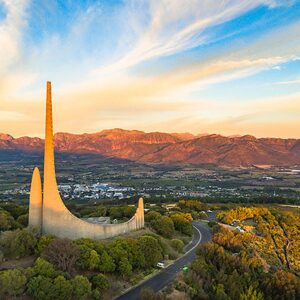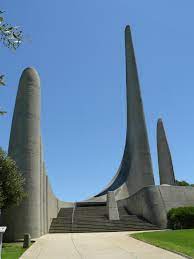The Afrikaans Language Monument is located in Paarl, South Africa. It was built to commemorate the establishment of Afrikaans as an official language of South Africa in 1925. The monument is an iconic structure designed to represent the growth and development of the Afrikaans language and culture.
The Afrikaans Language Monument, or “Afrikaanse Taalmonument” in Afrikaans, stands proudly atop Paarl Mountain in the Western Cape province of South Africa. This striking monument is not only a symbol of the Afrikaans language but also a testament to the cultural heritage and identity of the Afrikaans-speaking community.
South Africa’s Western Cape province stands as a symbol of cultural pride and linguistic heritage: the Afrikaans Language Monument. Nestled in the picturesque town of Paarl, this monument stands as a tribute to the rich tapestry of Afrikaans language and culture, a testament to the resilience and identity of its speakers.
An amazing Glimpse of the Afrikaans Language Monument in a video: https://www.youtube.com/watch?v=g1NP_j6S5FU
A Beacon of Identity
Constructed in 1975, the building serves as a tangible reminder of the significance of language in shaping a nation’s identity. Afrikaans, a language with roots deeply intertwined with the complex history of South Africa, has evolved over centuries, influenced by Dutch, Malay, Khoisan, and other languages. Despite facing challenges and controversies, Afrikaans has persevered, becoming one of South Africa’s official languages and a key component of its cultural landscape.
The construction of the building coincided with a period of heightened cultural and linguistic awareness among Afrikaans speakers. It was built during the apartheid era, a time marked by segregation and political turmoil. As such, the monument also serves as a reminder of the struggles and triumphs of Afrikaans-speaking communities throughout South Africa’s history.
Architectural Symbolism
Designed by architect Jan van Wijk, the monument’s architecture is laden with symbolism, reflecting the journey of the Afrikaans language and its speakers. The central tower, rising proudly into the sky, represents the growth and strength of the language. Surrounding it, the curved walls symbolize the diverse influences that have shaped Afrikaans over time, while the stone sculptures and reliefs depict scenes from Afrikaans literature, folklore, and history.
The design of the Afrikaans Language Monument is not only symbolic but also innovative. Its unique blend of modernist and postmodernist architectural styles garnered international acclaim, earning it recognition as a National Monument of South Africa. The monument’s geometric forms and use of natural materials blend seamlessly with the surrounding landscape, creating a harmonious union of art and nature.

Cultural Significance
Beyond its architectural beauty, it holds immense cultural significance for South Africans. It serves as a gathering place for celebrations, cultural events, and educational programs, fostering a sense of pride and belonging among Afrikaans speakers. The monument’s museum and multimedia displays provide visitors with insights into the language’s origins, evolution, and contributions to South African society.
In a rapidly changing world, the Afrikaans Language Monument stands as a bastion of heritage preservation. By honoring and celebrating the Afrikaans language and culture, the monument ensures that future generations will continue to appreciate and cherish their linguistic roots. It serves as a reminder that language is not just a means of communication but a powerful tool for preserving history, expressing identity, and fostering unity.
Throughout the year, the Afrikaans Language Monument hosts a variety of cultural events and festivities. These include concerts, theatrical performances, poetry readings, and art exhibitions, showcasing the vibrant creativity and talent of Afrikaans-speaking artists and performers. These events not only attract local visitors but also draw tourists from around the world, contributing to the cultural and economic vitality of the region.
A Call for Inclusivity
While the Afrikaans Language Monument celebrates the achievements of Afrikaans speakers, it also sparks conversations about inclusivity and reconciliation in South Africa. As a language historically associated with the apartheid regime, Afrikaans carries complex connotations for many South Africans. Thus, the monument serves as a space for dialogue and reflection, inviting people from all backgrounds to engage with its history and significance.
Despite its historical associations with the apartheid regime, the Afrikaans Language Monument has become a symbol of unity and reconciliation in post-apartheid South Africa. It serves as a space where people from diverse backgrounds can come together to celebrate their shared heritage and cultural diversity. Through dialogue and engagement, the monument fosters mutual respect and understanding among different linguistic and cultural communities, contributing to the country’s ongoing process of nation-building and social cohesion.

In Conclusion
In addition to its role as a cultural landmark, the Afrikaans Language Monument serves as an educational resource for students and scholars interested in linguistics, history, and heritage studies. The monument offers guided tours, workshops, and educational programs designed to deepen visitors’ understanding of the Afrikaans language and its cultural significance. It also collaborates with schools and universities to promote language learning and literacy among young people.
Beyond its local significance, the building has also inspired similar initiatives around the world. Its success in celebrating linguistic and cultural identity has prompted other communities facing language revitalization efforts to consider the establishment of their own language monuments. By sharing its experiences and insights, the building continues to serve as a source of inspiration for cultural preservation efforts globally.
In the picturesque landscape of Paarl, the Afrikaans Language Monument stands as a symbol of resilience, pride, and cultural heritage. Through its striking architecture and profound symbolism, it pays homage to the Afrikaans language and its enduring legacy in South Africa. As a beacon of identity and a catalyst for dialogue, the monument continues to inspire and unite people, fostering a deeper appreciation for the diverse linguistic and cultural tapestry of the nation.
Read More: https://placesandlifestyle.com/amazing-structures-in-antarctica/




